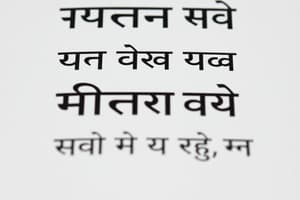Podcast
Questions and Answers
Which script is used to write Hindi?
Which script is used to write Hindi?
- Greek
- Cyrillic
- Devanagari (correct)
- Roman
What is the general word order in Hindi?
What is the general word order in Hindi?
- Subject-Verb-Object (SVO)
- Object-Subject-Verb (OSV)
- Subject-Object-Verb (SOV) (correct)
- Verb-Subject-Object (VSO)
From which dialect is Hindi derived?
From which dialect is Hindi derived?
- Marwari
- Awadhi
- Bhojpuri
- Khariboli (correct)
Which of the following is a category of words in Hindi, referring to words borrowed from Sanskrit?
Which of the following is a category of words in Hindi, referring to words borrowed from Sanskrit?
What type of script is Devanagari?
What type of script is Devanagari?
In Hindi grammar, how are nouns classified?
In Hindi grammar, how are nouns classified?
What is the headline called that appears on each word in Devanagari script?
What is the headline called that appears on each word in Devanagari script?
Which of the following is a goal of Hindi classes?
Which of the following is a goal of Hindi classes?
Which teaching methodology focuses on grammatical rules and translation exercises?
Which teaching methodology focuses on grammatical rules and translation exercises?
Which of the following is a challenge in learning Hindi?
Which of the following is a challenge in learning Hindi?
What type of assessment evaluates speaking and listening skills in Hindi classes?
What type of assessment evaluates speaking and listening skills in Hindi classes?
Which ancient text is foundational to Hindi literature?
Which ancient text is foundational to Hindi literature?
What role does Hindi play in India?
What role does Hindi play in India?
Which dialect served as the basis for modern standard Hindi?
Which dialect served as the basis for modern standard Hindi?
What kind of support do language learning communities and forums offer to Hindi teachers?
What kind of support do language learning communities and forums offer to Hindi teachers?
Which of the following is an example of a teaching aid for Hindi teachers?
Which of the following is an example of a teaching aid for Hindi teachers?
Flashcards
Grammar-translation method
Grammar-translation method
Focuses on grammatical rules and translation exercises.
Communicative Approach
Communicative Approach
Creating real-life situations for practical communication.
Audio-lingual method
Audio-lingual method
Focuses on listening and speaking through repetition.
Task-based learning
Task-based learning
Signup and view all the flashcards
Hindi Pronunciation Challenge
Hindi Pronunciation Challenge
Signup and view all the flashcards
Written Exams (Hindi)
Written Exams (Hindi)
Signup and view all the flashcards
Significance of Hindi
Significance of Hindi
Signup and view all the flashcards
Khariboli dialect
Khariboli dialect
Signup and view all the flashcards
What is Hindi?
What is Hindi?
Signup and view all the flashcards
Hindi's Origin
Hindi's Origin
Signup and view all the flashcards
Devanagari Script
Devanagari Script
Signup and view all the flashcards
Hindi Grammar Basics
Hindi Grammar Basics
Signup and view all the flashcards
Tatsam
Tatsam
Signup and view all the flashcards
Tadbhav
Tadbhav
Signup and view all the flashcards
Deshaj
Deshaj
Signup and view all the flashcards
Videshi
Videshi
Signup and view all the flashcards
Study Notes
- Hindi is a language.
- There are 12 Hindi classes.
Basics of Hindi Language
- Hindi is an Indo-Aryan language spoken chiefly in India.
- It is the official language of the Union of India and an additional official language of India.
- Hindi is the lingua franca of the Hindi belt and much of North India.
- As a standardized and Sanskritized register of the Hindustani language, Hindi is derived from Khariboli dialect of Delhi.
- Hindi is written in the Devanagari script.
Hindi Classes
- Hindi classes encompass a range of educational settings, including primary schools, secondary schools, universities, and private language institutions.
- The goal of Hindi classes is to teach students to speak, read, and write in Hindi.
- Course content includes Hindi grammar, vocabulary, and literature.
- Hindi classes often focus on cultural aspects, such as festivals, traditions, and history.
- The number of Hindi classes varies from region to region and depends on the demand and resources available.
Hindi Grammar
- Hindi grammar is based on the Khariboli dialect.
- Nouns in Hindi are classified by gender (masculine or feminine) and number (singular or plural).
- Verbs in Hindi are conjugated based on tense, aspect, mood, gender, and number.
- Hindi word order is generally subject-object-verb (SOV).
- Postpositions (similar to prepositions in English) follow the noun they modify.
Vocabulary
- Hindi vocabulary includes words of Sanskrit, Prakrit, Persian, Arabic, and English origin.
- तत्सम (Tatsam): words directly borrowed from Sanskrit.
- तद्भव (Tadbhav): words derived from Sanskrit but changed over time.
- देशज (Deshaj): words of local or indigenous origin.
- विदेशी (Videshi): words borrowed from foreign languages.
Devanagari Script
- The Devanagari script is used to write Hindi, Marathi, Nepali, and Sanskrit.
- It is an abugida script, where each consonant has an inherent vowel (usually 'a').
- Vowels can be written as independent letters or as diacritics attached to consonants.
- Devanagari is written from left to right.
- Each word in Devanagari has a headline (shirorekha).
Learning Resources
- Textbooks are a primary resource for language learning.
- Online courses and language learning apps are now popular for remote learning.
- Language exchange partners can help improve conversational skills.
- Dictionaries and glossaries provide meaning and usage of words.
- Literature, films, and music exposure enhances comprehension and cultural understanding.
Teaching Methodologies in Hindi Classes
- Grammar-translation method focuses on grammatical rules and translation exercises.
- Communicative approach involves creating real-life situations for practical communication.
- Audio-lingual method focuses on listening and speaking through repetition.
- Task-based learning involves completing tasks using the language.
- Immersion programs involve immersing the student in a Hindi-speaking environment.
Challenges in Learning Hindi
- Pronunciation: Hindi has sounds that may not exist in other languages.
- Gendered Nouns: Determining which nouns are masculine or feminine can be difficult.
- Verb Conjugation: Hindi verb conjugation can be challenging.
- Script: Learning the Devanagari script requires memorization and practice.
- Cultural Context: Understanding the cultural context of the language is crucial.
Assessment Methods in Hindi Classes
- Written exams assess grammar, vocabulary, and comprehension.
- Oral exams evaluate speaking and listening skills.
- Assignments, such as essays and presentations, apply language skills.
- Quizzes test understanding of specific topics.
- Projects involve research and creative use of the language.
Hindi Literature
- Hindi literature includes a wide range of genres, such as poetry, novels, short stories, and drama.
- Important figures in Hindi literature include Tulsidas, Premchand, and Mahadevi Varma.
- Ancient texts like the Ramcharitmanas are foundational to Hindi literature.
- Modern Hindi literature explores contemporary social issues.
- Literary movements have shaped the development of Hindi literature.
Significance of Hindi
- Hindi is the official language of India, used in government and administration.
- It is a major language in media, including film, television, and print.
- Hindi is important for cultural and social integration in India.
- It provides access to a rich literary and cultural heritage.
- Learning Hindi can enhance career opportunities in various fields.
- Hindi is spoken by a large diaspora population around the world.
Evolution of Hindi
- The evolution of Hindi can be traced through various stages of linguistic development, including Old Indo-Aryan (Vedic Sanskrit), Middle Indo-Aryan (Prakrit, Pali), and New Indo-Aryan (Apabhramsa, Hindavi).
- Khariboli dialect served as the basis for modern standard Hindi.
- Standardisation efforts in the 19th and 20th centuries shaped the language.
- Influence from Persian, Arabic, and English enriched the vocabulary.
- Contemporary Hindi continues to evolve with new words and expressions.
Resources for Hindi Teachers
- Teacher training programs provide pedagogical skills and language proficiency.
- Curriculum development resources help in designing effective lessons.
- Teaching aids, such as textbooks, multimedia, and online tools, can facilitate learning.
- Professional development workshops enhance teaching skills.
- Language learning communities and forums offer support and resources.
Studying That Suits You
Use AI to generate personalized quizzes and flashcards to suit your learning preferences.




